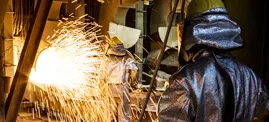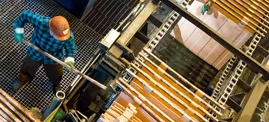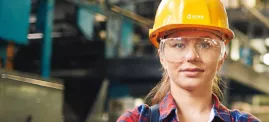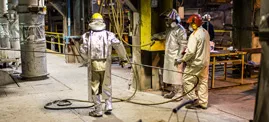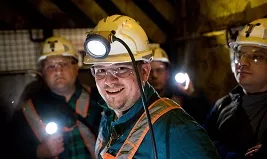The Management Board of KGHM Polska Miedź S.A., in accordance with corporate governance principle 18 of the document "Best practices in public companies 2005" hereby provides the text of the Concise evaluation of the situation in KGHM “Polska Miedź” S.A. as carried out by the Supervisory Board of the Company.
Concise evaluation of the situation in KGHM “Polska Miedź” S.A., presented to the General Shareholders Meeting of KGHM Polska Miedź S.A. in Lubin
(approved by the Supervisory Board of KGHM “Polska Miedź” S.A. on 25 April 2005)
1. Macroeconomic conditions in 2004. In 2004 there was a significant increase in the prices of the majority of raw materials on global markets, including in particular a sudden rise in copper and silver prices. The average annual electrolytic copper price on the London Metal Exchange (LME) reached 2 868 USD/t and was 61.1% higher than the average for the year 2003 (1 780 USD/t). Despite the rise in global mine copper production by 4.6%, copper inventories in the warehouses of the LME fell, by the end of the year, to 49 000 t, which is the lowest level recorded since 1990.
Silver prices meanwhile reached 6.66 USD/troz (1 troy ounce = 31.1 g) representing an increase by 36.3% in relation to 2003 (4.88 USD/troz).
This positive effect was somewhat reduced by the impact of the fall in the USD exchange rate by 6.2%, whose annual average in 2004 was 3.65 PLN/USD versus the rate in 2003 of 3.89 PLN/USD, and by the significant increase in the prices of steel-based products, fuels and energy.
Nonetheless, the end result was the creation of highly advantageous market conditions for the Company.
With production of 531 thousand tonnes of copper in concentrate, KGHM Polska Miedź S.A. accounted for 3.7% of global production (world – 14 531 thousand tonnes), while the production of silver in concentrate in the amount of 1 373 t gave the Company second place, with a 10% share in global production.
2. Basic results and significant events. In March 2004, the Supervisory Board performed a change of the President and of two Members of the Management Board. The new Management Board is continuing to carry out a strategy, accepted by the Management Board and the Supervisory Board, aimed at concentrating strength and resources on the core business, i.e. the mining and metallurgy of copper and silver and of associated metals, along with assuming the further development of the Company and an increase in its value.
Assuming an increase in production and taking into account the advantageous macroeconomic conditions, the Management Board submitted a proposal in June of 2004 on adjustment of the budget for 2004 which increased, among others: planned revenues from sales by 14.4%, net profit by 105.8% and the unit electrolytic copper production cost by 4.4%. The Supervisory Board approved this adjusted budget on 30 June 2004.
In 2004 there was an increase, in comparison to the prior year, of mining production, calculated as the amount of ore extracted, by 6.28%. Electrolytic copper production increased by 3.9%, silver by 9.9% and gold by 48.0%. This latter high increase was due to the contractual processing of gold-bearing material.
These good production results were accompanied by significant economic results. The Company achieved a net profit of PLN 1 397.2 mln (an increase versus 2003 by 163.8% and versus the adjusted budget by 4.1%), an increase in the value of sales to PLN 6 057 mln, i.e. by 29.1 %, including copper by 33.8%, silver by 8.4% and gold by 38.2%. Also exceeded was the adjusted budget as respects copper sales, by 2.12%, and silver by 6.3%.
The gross profit margin reached 23.5% (an increase versus 2003 by 158.2%), and the net profit margin 22.7% (an increase by 69.4%). EBITDA amounted to PLN 1 643 mln and increased by 151.5%, profit per share amounted to PLN 6.99 (an increase by 163.8%). The result on financial activities in the Company in 2004 was radically different from that assumed in the budget, closing at the level of 21% of assumptions.
Return on assets (ROA) amounted to 15.6% (an increase by 141.9%), while return on equity (ROE) amounted to 26.2% (an increase by 72.4%). The unit electrolytic copper production cost amounted to 6 660 PLN/t, i.e. PLN 10/tonne lower than that in the adjusted budget, and increased by 6.8% versus 2003. There was also an increase in the unit electrolytic copper production cost expressed in USD by 14%, among others due an increase in the PLN exchange rate. This increase in the unit cost was mainly caused by an extremely high increase in the prices of steel-based products, fuels and energy as well as of copper-bearing scrap used as smelter batches, as well as wages.
Employment at the end of 2004 amounted to 17 767 persons, representing a decrease by 2.3%, along with a further, though slightly slower increase, in the average monthly wage to PLN 5 597, i.e. by 7.9% (an increase in 2003 by 8.6%).
3. Problems having a particular impact on the Company. The significant economic results described above decidedly improved the credit standing of the Company. The debt ratio, from a level of 41.0% at the end of 2003, decreased to 24.0%, i.e. by 40.0%. Liabilities due to loans amounted at the end of the year to PLN 240 mln (a decrease by 85.6%).
The high increase in copper prices, which was unforeseen by analysts, led to a hedging cost, which was charged to costs by PLN 911.3 mln when balanced with income from currency hedging, while the revaluation reserve increased by PLN 474.0 mln to PLN 874.7 mln, i.e. by 100.0%. There was a decrease in financial liabilities due to the valuation of financial instruments to PLN 593.6 mln and an increase in financial assets in this regard to PLN 512.3 mln; this improved the end result, from (PLN 385.0 mln) to (PLN 81.3 mln), i.e. by PLN 303.7 mln.
The receiveables turnover cycle was shortened by one day to 25 days, while the liabilities turnover cycle was lengthened, from 30 to 35 days, and the inventories turnover cycle from 66 to 70 days. There was an improvement in liquidity ratios: the current ratio from 1.18 to 1.23 and the quick ratio from 0.75 to 0.77.
There was an increase of equity on the total balance sheet from 42.3% to 59.6%.
In 2004 there was a further increase in off-balance sheet liabilities due to R&D implementation work, inventions and other unrealised contracts by 18.3%, to PLN 118.1 mln. Despite the statements included in the document “Concise evaluation of the situation in KGHM Polska Miedz S.A.” for 2003, the Management Board did not present the Supervisory Board with the results of this audit, nor did it change regulations and standards in this regard.
Investment expenditures increased by 45.4% in 2004, to PLN 616.4 mln, including an increase in mining expenditures by 61.5% to PLN 483.3 mln. There was also a further decrease in depreciation by 7.7% to PLN 273 mln, which alongside an increase in costs led to a decrease in the share of depreciation in the costs structure from 7.0% to 5.7%, and an increase in the share of costs of materials and energy from 33.8% to 38.1%. The share of labor costs decreased from 34.2% to 32.4%.
Due to changes in geological conditions the average annual content of copper in mined ore decreased from 1.99% to 1.97%, which was balanced by an increase in the amount of ore excavated.
In 2004 there was an improvement in work safety results. There was a total of 582 accidents, representing a decrease by 20.7%, including four category I accidents, representing a decrease by 55.6%. In addition to the decrease in the number of accidents, there was also a decrease in the frequency factor, from 40.81 to 32.81, although unfortunately there was an increase in their severity, calculated as the average amount of working days lost per accident, from 44.78 in 2003 to 55.2 in 2004. Work safety must continue to be a priority task for the management and employees of the Company.
4. General comments. As mentioned above, the bull market in copper and silver prices was a decisive factor in the good results of the Company in 2004. Hedging contracts which were entered into to hedge against a decrease in the prices of goods in this case had an opposite effect, causing a partial loss in potential revenues. This should not however lead to a failure to pursue a hedging strategy. Nearly all of the revenues of KGHM arise from only two products, copper and silver. The Company has absolutely no impact on their market prices. It is therefore necessary to pursue a hedging strategy, whose amount and volume must be subject to constant analysis by a team of highly-qualified and experienced specialists under the supervision of the Management Board of the Company.
Another element which is affected by the the way in which it is managed is costs. Disciplined realisation of the plan to reduce costs is a basic task of the Management Board.
In 2004 the Management Board completed an update of the Technical-Economic Plan for the period 2005 to 2009, as well as the Development Program to the year 2020. The Supervisory Board approved both these documents in March 2005. The Technical-Economic Plan foresees the realisation of investments for modernising technology which is closely related to the program to decrease unit copper production costs, as well as of mining-related investments aimed at accessing further ore resources, thereby ensuring continuity in the production of copper and silver. Within the framework of this plan a license was procured for the extraction of copper ore from the “Głogów Głęboki Przemysłowy” deposit, and feasibility studies were completed related to construction of the new SW-4 shaft, together with infrastructure, which will enable the extraction of ore from deposits included in the licensed area of the Polkowice-Sieroszowice Mining Division to a depth below 1000 m.
An audit performed by the Supervisory Board Audit Committee on the implementation of recomendations from an audit, performed by an independent auditor, of processes related to the ordering of supplies and services, concurred in the realisation of these recomendations, although in order to properly control such expenditures these processes must be continuously monitored by internal Company audits, with their results reported to the Management Board.
As mentioned above, there was a further increase in liabilities due to the implementation of inventions and of R&D work. The external audit recommended by the Supervisory Board of procedures applied in this regard was not implemented by the Management Board. The Management Board must take decisive steps in this matter in order to clarify all of their concerns within a short period of time, and to improve procedures related to decision making and to the signing and realisation of contracts in this regard in order to transparently protect the interests of the Company.
There was an improvement in the implementation of IT systems for the management of the Company. Implementation of the major parts of the following modules was completed: the staff-wages module, the module for calculating copper production costs and the first stage of the Balanced Scorecard. However, in the opinion of the Supervisory Board the computerisation of management systems remains at a low level, particularly with regard to the management of production, the utilisation of mining equipment and update information for management on the current state of production in the Company. The execution of a working schedule of tasks in this regard must be continuously monitored by the Management Board.
The above-described state of the Company at the end of 2004 implies favorable conditions for operations in 2005. Intensive continuation of the organisational and IT-related activities described above, further improvement in procedures followed by the Company and the Group, implementation of a Quality Management System and of a related management incentives system, as well as constant control of the costs reduction program should ensure the continuation of good results and retention of the value of the Company in 2005. Realisation of the development program and modernisation of production ensures the continuation of production and operations into the foreseeable future.
The Supervisory Board of KGHM Polska Miedź S.A.
April 2005
(Translation from the original Polish version. In the event of differences resulting from the translation, reference should be made to the official Polish version.)

